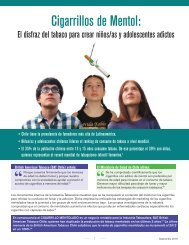Public health successes and missed opportunities
Public-health-successes-and-missed-opportunities-alcohol-mortality-19902014
Public-health-successes-and-missed-opportunities-alcohol-mortality-19902014
Create successful ePaper yourself
Turn your PDF publications into a flip-book with our unique Google optimized e-Paper software.
<strong>Public</strong> <strong>health</strong> <strong>successes</strong> <strong>and</strong> <strong>missed</strong> <strong>opportunities</strong><br />
Fig. 71. Trends in age-st<strong>and</strong>ardized adult mortality due to alcohol-attributable intentional injury for Armenia,<br />
Azerbaijan, Georgia, Kazakhstan, Kyrgyzstan, Tajikistan, Turkey, Turkmenistan <strong>and</strong> Uzbekistan, 1990–2014<br />
200<br />
Armenia<br />
Azerbaijan<br />
Georgia<br />
Rate per million<br />
150<br />
100<br />
50<br />
Kazakhstan<br />
Kyrgyzstan<br />
Tajikistan<br />
Turkey<br />
Turkmenistan<br />
Uzbekistan<br />
WHO<br />
European Region<br />
0<br />
1990<br />
1992<br />
1994<br />
1996<br />
1998<br />
2000<br />
2002<br />
2004<br />
2006<br />
2008<br />
2010<br />
2012<br />
2014<br />
WHO Euro<br />
Regional differences in alcohol-attributable mortality<br />
Uzbekistan<br />
OVERALL TREND IN ALCOHOL-ATTRIBUTABLE MORTALITY BETWEEN 1990 AND 2014 BY MAJOR<br />
CAUSE-OF-DEATH CATEGORIES<br />
Turkey<br />
Fig. 72 gives an overview of the age-st<strong>and</strong>ardized alcohol-attributable mortality rates per million by major categories<br />
of cause of death at the beginning <strong>and</strong> the end of the observation period, i.e. 1990 <strong>and</strong> 2014. For the WHO European<br />
Region as a whole, there was higher alcohol-attributable mortality in 2014 than in 1990 (+4%), even though the overall<br />
consumption decreased slightly over this time period (see Fig. 10). The increase in attributable mortality burden was<br />
mainly driven by the mortality trends in the eastern WHO European Region (+22%) <strong>and</strong> in the south-eastern part of<br />
the WHO European Region (+65%, albeit from a relatively low level in 1990). On the other h<strong>and</strong>, alcohol consumption<br />
decreased in more affluent countries such as most parts of the EU, more in the Mediterranean (–27%) <strong>and</strong> the centralwestern<br />
(–25%) than in the central-eastern regions (–15%).<br />
The increase in the burden of alcohol-attributable mortality in the WHO European Region, despite a small decrease in<br />
overall per capita consumption, is due to a number of reasons: first <strong>and</strong> foremost, the exponential increase in mortality risk<br />
for many cause-of-death categories with increasing levels of average consumption (159–161), which led to a substantial<br />
increase in alcohol-attributable mortality, especially in regions where already high consumption levels per drinker further<br />
increased (see the eastern WHO European Region in Fig. 13 <strong>and</strong> 14). Second <strong>and</strong> related to this, heavy drinking occasions<br />
have a specific detrimental effect on cardiovascular <strong>and</strong> injury mortality, over <strong>and</strong> above the level of drinking (see also<br />
next paragraph). Finally, the Russian Federation <strong>and</strong> surrounding countries can be characterized by an overall raised<br />
adult mortality rate <strong>and</strong> low life expectancy (141,162), which had even led to a separate mortality stratum in the WHO<br />
classification (163,164).<br />
The decrease in alcohol-attributable mortality in the central-eastern EU countries was due to an overall decline in mortality<br />
rates in this region (141,162). Even with stable alcohol-attributable fractions or slightly increasing alcohol-attributable<br />
fractions, such a decline results in lower st<strong>and</strong>ardized rates.<br />
50




